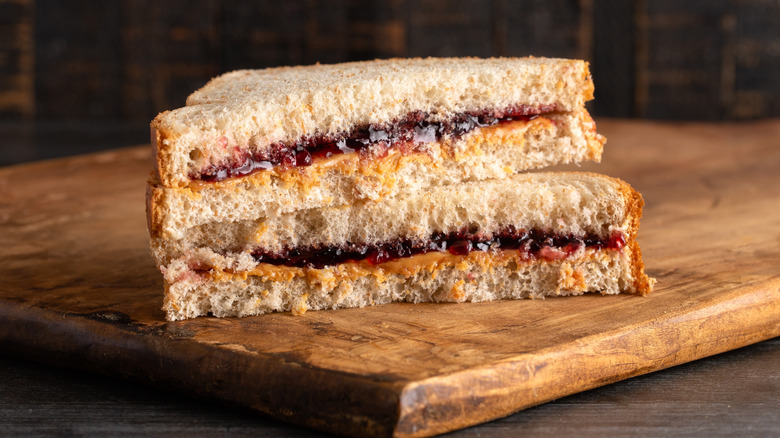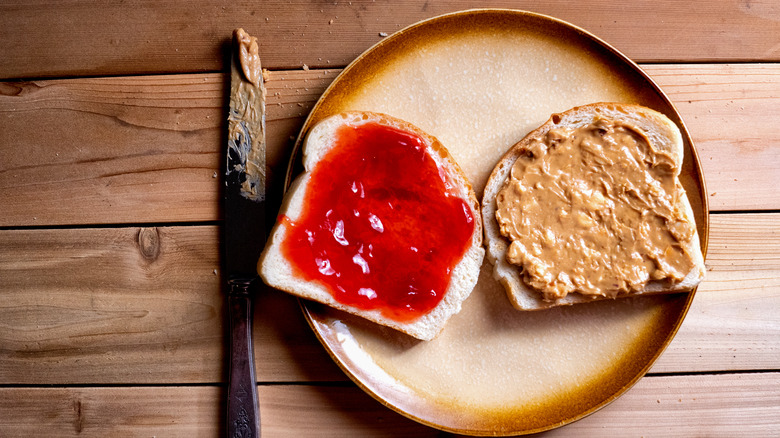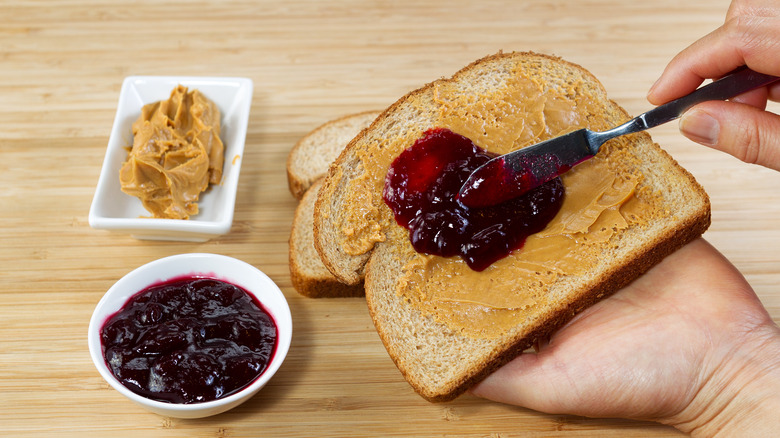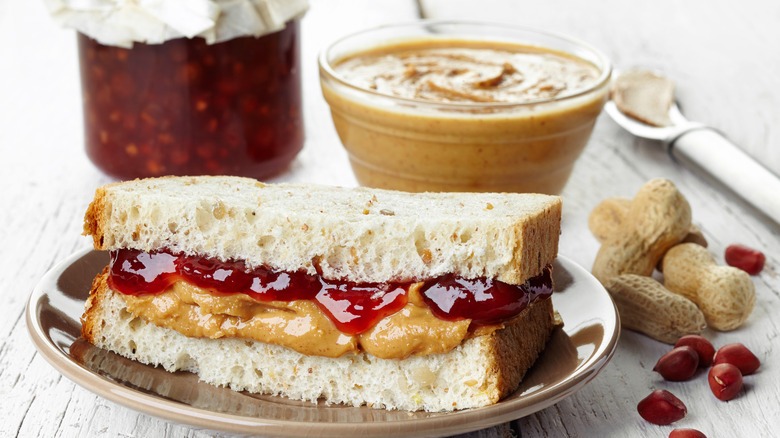PB&J: The History Of The Peanut Butter And Jelly Sandwich
Countless peanut butter and jelly sandwiches are made every day as kids get ready for school. And while that's not surprising, I got to wondering: Who invented the peanut butter and jelly sandwich? When I was growing up, my dad made our school lunches. He's great at a great many things, my dad, but cooking/meal prep was/is not one of them. This is a guy who, when asked about the best meals he makes, is likely to remark with one of three things — toast, cereal, or Eggo waffles.
He's added some things to his repertoire throughout the years, but when it came to packing our lunches, he stuck to the basics — a piece of fruit, a bag of chips, a Hostess treat (my go-to was the cupcake), and one or two peanut butter and jelly sandwiches. Nothing fancy. Nothing complex. That said, he did make a mean PB&J. In fact, it's one of the rare things he made better than my mom. I don't know what it was about peanut butter and jelly that threw her for a curve, but she always seemed to struggle with the proper ratios. I digress.
The perfection of PB&J
In many ways, peanut butter and jelly is the perfect kid's lunch food. First, it's cheap. A child's palate likely isn't quite as refined, so dropping a ton of cash on freshly sliced prime rib lunch meat probably isn't necessary. Second, it's soft. Little kids don't want to struggle when they eat. Third, it can be consumed at room temperature. If you pack a lunch at 7 a.m. and it's left in a backpack or locker until noon, cold cuts and cheese can get pretty dicey over the span of five hours. And fourth, it's easy. It takes so little time and effort to make and, as a parent, time and effort are precious resources I like to conserve. Finally, it's appealing. The combination of sweet and salty covers the basic cravings of a child (or me).
Given all this, it's safe to say Americans eat a lot of peanut butter and jelly — and to honor the humble but enduring pair, April 2 has even been declared National Peanut Butter and Jelly Day. I've seen some estimates that suggest the average person eats well over a thousand such sandwiches during childhood. Frankly, unless you're allergic, I think that's a pretty safe bet. As with many similarly popular foods — hot dogs, burgers, and pizza — I think we often take for granted that there was a time when these staples didn't exist. Like any other advancement, someone had the ingenuity to innovate and create.
So, who invented peanut butter and jelly sandwiches?
It seems so basic, so obvious to us now, but the peanut butter and jelly sandwich didn't always exist. In fact, all things considered, it's a pretty recent phenomenon. Most accounts date the PB&J to the early 1900s. According to the Mark McWilliams book, "The Story Behind the Dish: Classic American Foods," a woman by the name of Julia Davis Chandler published the first recipe of a sandwich that combined peanut butter and jelly in 1901.
Prior to this, there had been several recipes for making peanut butter and spreading it on a slice of bread. In fact, according to the National Peanut Board (NPB), peanut butter itself started to gain in popularity after being introduced at the 1893 World's Fair in Chicago, Illinois. Still, it wasn't until 1901 that the epic combo of peanut butter and jelly made its appearance.
At that time, peanut butter was something of a delicacy. Per the NPB, it was an indulgence of high society and would get combined with (by today's standards) outrageous ingredients like pimento or watercress. But after the 1904 World's Fair in St. Louis, Missouri, peanut butter would become more reasonably priced as grocery stores began stocking it. Then, a perfect storm, of sorts, hit.
The ingredients became more widely available
In the early 1900s, a guy named Otto Rohwedder invented pre-sliced bread, making sandwiches a breeze to assemble. Then, a few years later, in 1917, Paul Welch (yeah, of Welch's) scored a patent for his process of making grape jelly (which WWI soldiers consumed and enjoyed). Because these ingredients were more accessible and, therefore, less expensive, the peanut butter and jelly sandwich moved from the affairs of the hoity-toity to Great Depression meal tables.
Still, according to the National Peanut Board, it wasn't until WWII that the PB&J became the American phenomenon it is. Why? Because peanut butter and jelly sandwiches were on soldiers' ration menus. After all, the ingredients were cheap, easy to come by, easy to combine, easy to consume at room temperature, and even easy to eat with one hand! Once the war ended and soldiers came home, they kept eating the sandwiches, and their popularity soared.
Over the years, the bread may have changed from white to wheat, allergies and food science may have given us options like almond butter, and culinary adventure may have shown us that one can replace jelly with bananas or even marshmallow fluff. That being said, there's only one combination so wonderfully perfect that it has become an American fixture like baseball, apple pie, and Chevrolet — peanut butter and jelly. So, the next time you're chowing down on a good old PB&J, remember — it's more than just a sandwich. It's a piece of Americana.



